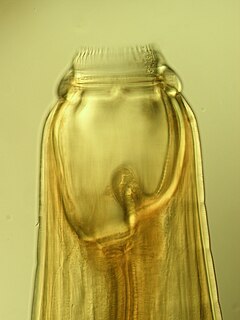 W
WAncylostoma is a genus of nematodes that includes some species of hookworms.
 W
WThe Ancylostomatidae are a family of worms that includes the hookworms.
 W
WCaenorhabditis angaria is a small nematode, in the same genus as the model organism Caenorhabditis elegans. The name is from the Latin after the tendency to ride weevils. Prior to 2011, the species was referred to as C. sp. 2, C. sp. 3, and C. sp. PS1010. Its genome was sequenced at the California Institute of Technology in 2010. This species is gonochoristic. It has distinct morphology and behavior compared to C. elegans; notably, C. angaria males exhibit a spiral mating behavior. Its divergence from C. elegans is similar to the distance between humans and fish. C. castelli is its closest relative, and the two species can produce F1 hybrids.
 W
WCaenorhabditis sinica, prior to 2014 described as sp. 5, is a species of nematodes in the genus Caenorhabditis. It is found in East Asia. It is found frequently in China.
 W
WHeterorhabditis bacteriophora is a species of entomopathogenic nematode known commonly as beneficial nematodes. They are microscopic and are used in gardening as a form of biological pest control. They are used to control ants, fleas, moths, beetles, flies, weevils, and other pests. They are also amenable to in vitro culture, making them also of interest to evolutionary and molecular biologists who investigate parasitic and symbiotic systems. Heterorhabditis bacteriophora was selected by the National Human Genome Research Institute as a sequencing target, the inbred strain H. bacteriophora TTO1 was sequenced using Roche 454 technology, and a high-quality 77 Mb draft genome assembly was produced in 2013. To reproduce the nematodes release Photorhabdus bacteria from their digestive tract thus killing these pests, then using the cadaver to grow and reproduce.
 W
WHeterorhabditis megidis is a species of nematodes in the genus Heterorhabditis. All species of this genus are obligate parasites of insects, and some are used as biological control agents for the control of pest insects.
 W
WNecator is a genus of nematodes that includes some species of hookworms. Necator americanus causes necatoriasis.
 W
WOdilia is a genus of nematode worms established by Marie-Claude Durette-Desset in 1973 that infect mostly murid rodents of the Australasian region (species of Melomys, Rattus and Uromys from mainland Australia and Tasmania.
 W
WSubclass Rhabditia is mostly composed of parasitic nematodes, though there are some free-living species as well. Phasmids are well-developed, while amphids are poorly developed or absent in this group.
 W
WRhabditida is an order of free-living, zooparasitic, and phytoparasitic microbivorous nematodes living in soil.
 W
WStrongyles, or alternatively, strongyls, are nematode worms of the family Strongylidae, order Strongylida. They are often parasitic in the gastrointestinal tract of mammals, especially grazers such as sheep, cattle and horses.
 W
WTrichostrongyloidea is a superfamily of nematodes under the order Strongylida.